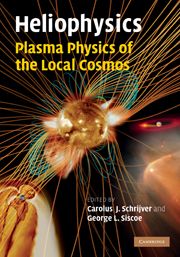Book contents
- Frontmatter
- Contents
- Preface
- 1 Prologue
- 2 Introduction to heliophysics
- 3 Creation and destruction of magnetic field
- 4 Magnetic field topology
- 5 Magnetic reconnection
- 6 Structures of the magnetic field
- 7 Turbulence in space plasmas
- 8 The solar atmosphere
- 9 Stellar winds and magnetic fields
- 10 Fundamentals of planetary magnetospheres
- 11 Solar-wind– magnetosphere coupling: an MHD perspective
- 12 On the ionosphere and chromosphere
- 13 Comparative planetary environments
- Appendix I Authors and editors
- List of illustrations
- List of tables
- References
- Index
9 - Stellar winds and magnetic fields
Published online by Cambridge University Press: 05 August 2013
- Frontmatter
- Contents
- Preface
- 1 Prologue
- 2 Introduction to heliophysics
- 3 Creation and destruction of magnetic field
- 4 Magnetic field topology
- 5 Magnetic reconnection
- 6 Structures of the magnetic field
- 7 Turbulence in space plasmas
- 8 The solar atmosphere
- 9 Stellar winds and magnetic fields
- 10 Fundamentals of planetary magnetospheres
- 11 Solar-wind– magnetosphere coupling: an MHD perspective
- 12 On the ionosphere and chromosphere
- 13 Comparative planetary environments
- Appendix I Authors and editors
- List of illustrations
- List of tables
- References
- Index
Summary
The solar wind is responsible for maintaining the heliosphere and is the driving agent in the magnetospheres of the planets; furthermore, it provides the mechanism by which the Sun has shed angular momentum during the aeons since its formation. We can assume that other cool stars with active coronae have similar winds, which play the same roles for those stars (Wood et al., 2005). The decade since the launch of SOHO has seen considerable changes in our understanding of thermally driven winds such as the solar wind, owing to theoretical, computational, and observational advances. Recent solar wind models are characterized by low coronal electron temperatures while proton, α-particle, and minor-ion temperatures are expected to be quite high and perhaps anisotropic. This entails an assumption that the electric field is relatively unimportant and that one is able to obtain in a quite natural way a solar wind outflow that has a high asymptotic flow speed while maintaining a low mass flux. In this chapter we will explain why these changes have come about and outline the questions now facing thermal wind astrophysicists.
The progress we have seen in the last decade is largely due to observations made with instruments on board Ulysses (McComas et al., 1995) and SOHO (Fleck et al., 1995). These observations have spawned a new understanding of solar wind energetics and the consideration of the chromosphere, corona, and solar wind as a unified system.
- Type
- Chapter
- Information
- Heliophysics: Plasma Physics of the Local Cosmos , pp. 225 - 255Publisher: Cambridge University PressPrint publication year: 2009
- 2
- Cited by



